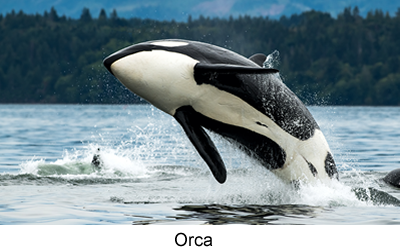 |
|
Name:
Orca (a.k.a Killer Whale) Classification:
Class: Mammalia
Order: Artiodactyla
Family: Delphinidae
Genus: Orcinus
Species: O.
orca
Size: 23 to 32 feet
long. Characteristics:
Long body, smooth skin, large pointed dorsal fin on back, pointed head,
large rounded fins. Status: data deficient.... They're big, they're beautiful, and they're known as "killer" whales. It turns out that this name is misleading, on two accounts! Orcas may be fearsome hunters, but they do not actively hunt humans. They are also not technically whales, but in fact the largest species of dolphin! Orcas are the most widespread mammals on Earth after humans. They can be found in every corner of the ocean across the world, though they especially like cold coastal waters. Orcas live in family groups or pods of up to forty individuals. They love to travel far and wide, swimming an average 40 miles a day. They also frequently dive 100-500 feet! Orcas love to eat just about anything that's smaller than they are, including fish, squid, seals, sea lions, sea birds, sharks, and even other whales and dolphins! A pod will work together to hunt and capture prey. Like other dolphins, orcas use echolocation, or bounce clicking noises off of objects, to find their prey. A pod will surround their prey and spew bubbles or strike them with their tails to disable them. This pack-like behavior has led many to call orcas the wolves of the sea. Sometimes orcas will even jump out of the water and temporarily beach themselves in an attempt to catch food! Orcas don't sleep; at least, not the way we do. Orcas are mammals, so they have to go to the surface to breathe periodically. If they went completely to sleep like humans do, they'd drown. Instead, they have the ability to make only half of their brain sleep at a time. Once "asleep", they swim slowly near the surface, resting with one eye closed. That's right-orcas literally sleep with one eye open! Female orcas will give birth to a single baby every three-to-ten years. They carry their baby for seventeen months before giving birth! The baby will nurse from its mother for as long as two years before either going on its own or joining the pod as an adult. Orcas status is classed as data deficient, which means there is not enough information to accurately determine if they are endangered or not. Some orca populations in Russia and the Pacific Northwest are considered endangered. Orcas face multiple threats, including toxic waste, noise pollution, tangling in nets, and collisions with boats. Some countries and territories, such as Greenland, Iceland and certain Caribbean islands, hunt orcas. The most famous of orca plights, however, is the marine park trade. Since the 1970s, Orcas have been taken from the wild and placed in parks, chief among them being SeaWorld. In captivity, orcas are often made to do tricks in shows. These parks claim to treat orcas well, but it has been well documented that orcas struggle in captivity. Orcas are highly social and intelligent creatures that are used to travelling great distances each day. Marine parks do not have the space needed to humanely house an orca. Captive orcas are usually kept in confined pools that give them little room to maneuver. These conditions have been proven to be physically and psychologically damaging to orcas. Some orcas have been bred in captivity, and these individuals don't typically do any better than wild-caught ones. Fortunately,
many people are working to do the orcas justice. In 2013, the documentary
Blackfish exposed the harsh living conditions for orcas
in SeaWorld. This led to a public outcry that pushed SeaWorld to stop
acquiring or breeding orcas in 2016, making their current orcas the
last generation to be held in captivity. Six months later, orca breeding
was banned in California. Canada is also considering a bill that will
ban keeping orcas or any cetaceans in captivity. In addition to these
reforms, the Washington Department of Fish and Wildlife has been making
strides to protect orcas. The organization WDC (Whale and Dolphin Conservation)
is also working hard to make the seas safer for orcas and other cetaceans. Wale and Dolphin Conservation,
Orca Page-Dedicated to protecting cetaceans of all colors and sizes! Washington Department
of Fish and Wildlife, Orca Page-Check out what the state of Washington
is doing for orcas! National Geographic,
"Orcas don't do well in captivity. Here's why."-More on why
orcas and captivity are not a good idea!
|
|
|
|
|
||
|
Contact
Us
|
||||
|
Taproot
Guru © ALL RIGHTS RESERVED
|
||||